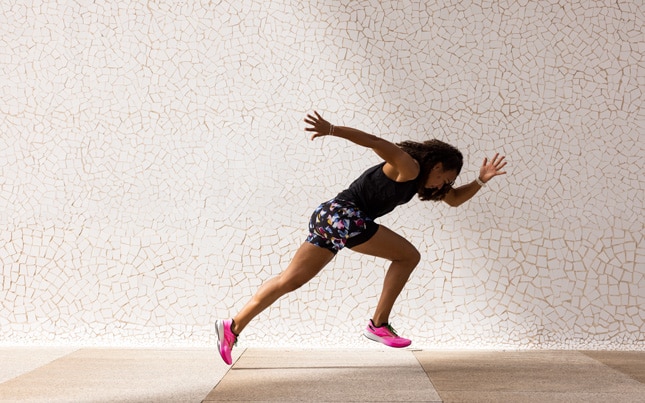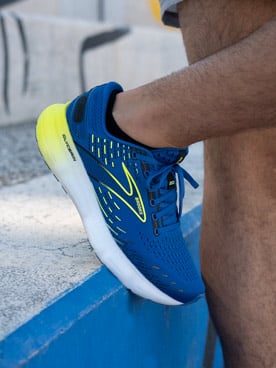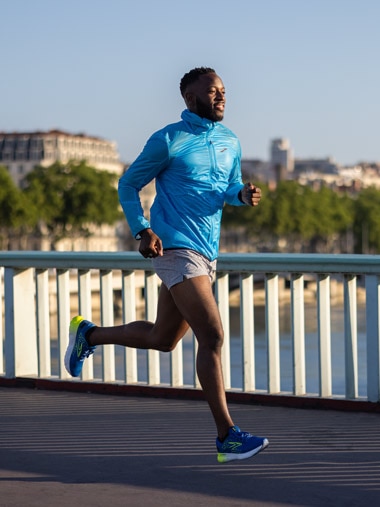How can I run for a longer period of time

Have you ever looked at runners completing 5ks, 10ks or even marathons and wondered how they do it? As a beginner runner, one of the biggest questions can be how to run for longer.
When you first start running, it can be hard. You might feel out of breath quickly, or maybe you feel aches and pains in places you didn’t even know could hurt. But there’s loads of positives to running too: you might feel the famous runner’s high once you’ve finished. Maybe you feel less stressed and in a better mood overall.
But as a beginner, you might not be able to run without stopping. That’s totally normal and it’s all part of the running journey. Whether you feel tired, sore or simply bored, you might find yourself wondering how to run longer without stopping. Even more experienced runners feel like this sometimes when they’re stepping up in distance or coming back from injury. But the good news is that you can get there. The more you run the easier it gets. So, with that in mind, here are our top tips on how to run longer.

Why is it hard to run without stopping?
As a beginner runner, you might feel frustrated if you can’t run for a full 30 minutes without stopping. But let’s make one thing clear: you’re not alone.
If you’re not used to running, it can be a shock to the system when you start. It’s demanding for both your cardiovascular system and your muscles, and if your cardiovascular endurance is low, you might quickly feel out of breath when running. That means it’s harder to keep running for extended periods. Similarly, when you start running, your muscles might not be conditioned. Even if you’ve done other sports or go to the gym regularly, running is a whole different ball game. It requires a different set of muscles, so if you’re not used to running, it may just take some time for your muscles to get up to speed. Also, like anything else – from sports to learning new skills or taking on a new job – you can’t expect to be a pro at it immediately. It can take time, experience and patience to get used to running. So, don’t be discouraged if you find running hard. We’ve all been there. Over time – and with a little help from our tips below – you’ll learn how to jog longer and build running endurance.
How to run longer (without getting out of breath)
Running for longer is a common goal for many new runners who want to improve their fitness, enter races, or simply run for a longer period without feeling fatigued. Here’s how to train yourself to run longer.
Try a run/walk strategy
There’s nothing to be ashamed about if you need to walk a little. In fact, some people use a run/walk technique for marathons and ultra marathons, to great success. Adding some walking breaks gives you the chance to take a breather, without having to stop completely. As your cardiovascular system gets more used to running, you can reduce and eventually remove the walk breaks altogether – or keep them in, if that’s your preference!
Pace yourself
If you set out on your run at top speed, it’s going to be harder to sustain it for a long period of time. Pace yourself and don’t go out too fast when you’re starting out. Rather than worrying about your pace, think about your effort level instead. Focus on how you’re feeling – if you’re breathing very heavily or feel fatigued, drop your pace down or slow to a walk. You can use the Rate of Perceived Exertion (RPE) scale to measure your effort level. This is a subjective way of rating your effort on a scale of 1-10, with 1 being very easy and 10 being maximum effort. You should aim to hit 5-6 on the RPE scale – not too easy, but not too hard either!
Be consistent
Make a schedule and stick to it. It’s okay if you deviate from it every now and again but if you do one run the first week then nothing for three weeks, then try to start again, your body is going to have a hard time. Instead, choose a realistic number of runs to add into your week – that might be two or three when you’re starting out. Then, try to be consistent in sticking to them, even if you have to swap the days around. There are no great secrets when trying to figure out how to run longer distances. Sometimes, keeping it simple is best. When you make running a regular part of your routine, your heart, lungs and muscles will learn to adapt over time, and you’ll naturally find that you can keep going for longer.


Run more often
Once you’re used to running, you can start adding more runs into your schedule. Let’s say you’ve been running two days a week for three weeks. Your body is starting to adapt, but you’ll reach a plateau where you find it harder to improve any further. Adding in another run each week will help you build more running endurance, enabling you to go for longer.
Improve your mental endurance
Half of the battle is mental. When you’re lacking the motivation to run or to run for 5 or 10 minutes longer, having mental grit can really help you to tough it out.
One strategy you can use to build mental strength in your running is positive self-talk. Start giving yourself little pep talks whenever you feel like quitting. It can be useful to have a mantra like “you’ve got this”, “you can do hard things” or “run the mile you’re in”. Whenever you’re having a wobble, repeat the mantra to yourself and let it work its mantra. Another simple way of building mental strength is listening to music. Find yourself a power song – one that will really amp you up, no matter how low you’re feeling. Then watch how it can perk you up even when you want to quit. Another good strategy is to find a running buddy. Join a running club or find some like-minded people to meet up with, even for one of your runs each week. You can give each other a boost when you need it most.
Always warm up
Warming up will help your muscles to get ready for your run – and cooling down afterwards will decrease the likelihood of you feeling sore afterwards. If you suffer from stitches or muscle soreness during your runs, preventing you from running for longer, warming up and cooling down could make a big difference.

How to run faster and longer
Once you’re running consistently without stopping, or using a run/walk strategy, you might want to start thinking about going further and faster. So, how to run faster and longer for beginners? First, it depends on what type of fast you’re aiming for. Take our speed quiz to figure out the best speed training and gear for your goals. Then, keep reading for a slightly more scientific approach for running faster and longer!
Vary your workouts
Once you’ve got some experience under your belt, you can start to mix up your training. If you want to get faster, it’s important to include some speed work within your training plan.
There are lots of different types of speed sessions you can do, including tempo runs, structured sessions and fartlek runs, which are one of the best ways to learn how to sprint faster and longer. Fartlek is a Swedish word that translates to ‘speed play’ in English, and it’s a flexible workout in which you dictate the pace which makes it great for beginners looking to add some speed to their runs. The idea is that you add in short bursts of speed to your run, for example, sprinting to the next lamppost, then running easy for a while, then sprinting to the next tree, for example. The short bursts of high-intensity running help to improve both your speed and endurance, challenging your cardiovascular system and developing anaerobic capacity – while the periods of easy running allow you to recover so you can run for longer.
Follow a training plan
Sometimes we all need a little help with our running. One of the best ways to learn how to run faster and longer (without getting tired!) is to follow a training plan. It’ll set out all the runs you need to do, helping you to stay on track to hit your goal and improve your speed and endurance – without overdoing it.
- Training for a 5k? Check out our 5k running plan.
- Want to achieve a dream of running a 10k? Our 10k training plan is for you.


Do strength training
You don’t need to spend hours in the gym, but adding in a couple of short strength sessions each week on days you’re not running will help to improve your running endurance. It’ll help to strengthen your muscles, give you more explosive power for faster running, and reduce muscle fatigue – so you can run for longer without getting tired.
Increase the length of your runs
It might sound obvious, but if you want to run longer distances, you need to run longer distances. If you’re following a training plan, it’ll outline exactly how long your runs should be (and sometimes what pace, too). But otherwise, increasing the length of your longest run by no more than 10% each week is a safe bet to ensure you keep progressing without doing too much, too soon.
Focus on your form
Efficient running form can help you to run faster and longer – with less effort. Focus on keeping an upright posture, relaxing your shoulders, and using your arms to drive yourself forward.
Invest in the right kit
Are you wearing the right shoes? Wearing a good pair of shoes can help you go faster and longer.
Shoes with proper cushioning can help to absorb the impact of each stride, which reduces the stress on your joints and muscles – and can help you to comfortably run for longer without getting tired. They can also help to provide stability, which can again improve your running efficiency and reduce the risk of injury. And if you choose a pair of running shoes made from responsive material, they can enhance your energy return with each stride, giving you a boost with every step so you can keep going mile after mile.

Learn to run for longer
Running for longer is an achievable goal for anyone – as long as you’re willing to put in some effort! By implementing the tips in this article, you can gradually start to build your running endurance and speed so you can conquer longer distances with confidence. So, what are you waiting for? Lace up, grab your running buddies and a PMA, and hit the road!